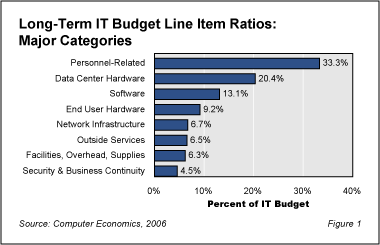Technology spending in business is highly dependent on the overall economy, and over the past decade IT executives have faced several major changes in economic conditions within which they have had to plan their annual expenditures. In just ten years, we have ridden the economic boom and dot-com frenzy of the late 1990s, passed through the Y2K crisis, suffered a recession in the early part of this century, and witnessed the growth of outsourcing and offshore services as a cost-cutting strategy. During the same period, IT platforms have been shifting from mainframe and client-server systems to Web-based platforms, including software on-demand or hosted applications.
One would think that these factors would have dramatic effects on the way businesses allocate their IT budgets. But a detailed analysis of IT budgets by line item over the past ten years shows otherwise. Although economic conditions have changed dramatically, the mix of spending within the corporate IT function is evolving slowly. Just as short-term changes in the weather can mask long-term climate trends, short-term changes in economic conditions can hide the long-term trends in IT budget priorities. Furthermore, the major changes in IT platforms over the past ten years has not had as dramatic an effect on the IT spending mix as might be expected.
This Research Byte is an executive summary of our article, Long-Term Trends in IT Budget Line Item Ratios [Purchase], which is derived from ten years of data from our IT spending and staffing surveys. We have conducted these surveys annually since 1990, the longest continually running survey of its type in the IT industry.
IT Budget Metrics and Budget Categories
The primary metric that we use to assess IT budget trends is the budgetary line item as a percent of the total IT budget. For example, if an IT department has a budget of $1 million dollars and it spends $400,000 on personnel, the personnel line item is 40% of the IT budget. The “percent-of-budget” metric is useful for analyzing long-term shifts in the IT spending mix because it is unaffected by overall changes in the IT budget. Using this metric, each budgetary line item may be viewed in terms of its relative priority in the IT budget.
Our annual IT spending survey analyzes nearly 20 budgetary line items. These 20 line items may be rolled up into major categories. Figure 1 shows the current budget ratios for eight categories of IT spending, based on linear regression over the number of years that we collected data for each line item.

As shown in Figure 1, the largest category of IT spending is personnel, which includes personnel compensation (for both employees and contractors/temps), recruiting expense, and employee training expense. IT departments spend far more on personnel than they do on any other category. This was true ten years ago, and it is still true today.
The full version of this article analyzes the long-term trend in IT personnel spending and what it means for the coming years. It also provides a similar analysis for the other categories of spending shown in Figure 1, breaking down each category into detailed line items including the following:
- Personnel-related IT budget trends, including IT compensation, training, and recruiting
- Data Center hardware budget trends, including mainframes, high-end servers, midrange servers, low-end servers, and storage area networks (SANs)
- Software budget trends, including operating system and utilities as well as application software
- End-User hardware budget trends, including desktops and laptops
- Network infrastructure budget trends
- Outside services budget trends
- IT facilities and overhead budget trends
- Consumable supplies budget trends
- Security and business continuity budget trends
The full version of this article also provides a breakdown of all 20 budget line items and their current percentages of the IT budget, based on linear regression for the number of years that we collected data on each line item. Implications for budgetary strategy are also highlighted with practical recommendations based on these trends.
This Research Byte is an executive summary of our article, Long-Term Trends in IT Budget Line Item Ratios, which can be purchased from at the following link: https://avasant.com/report/long-term-trends-in-it-budget-line-item-ratios-2006/.

